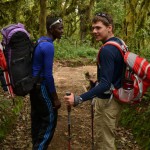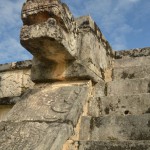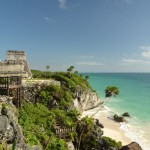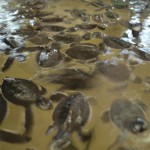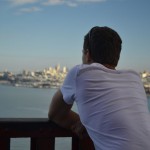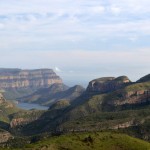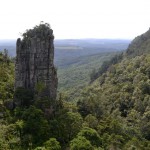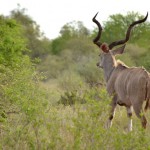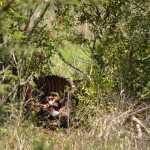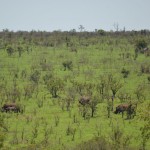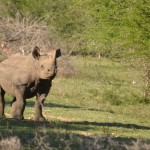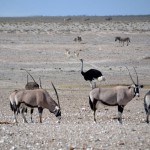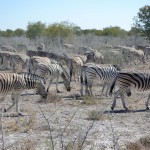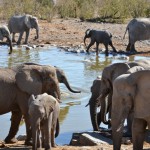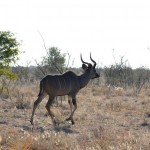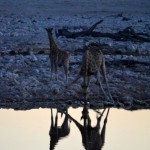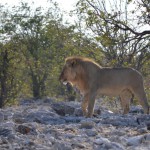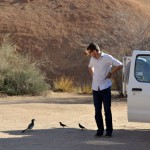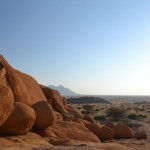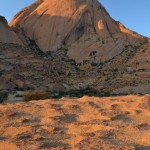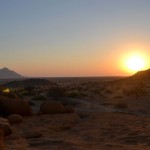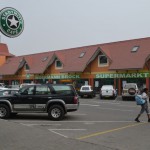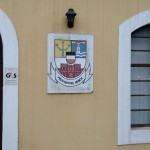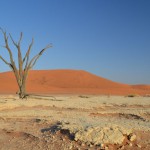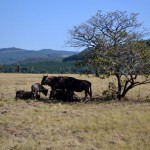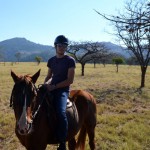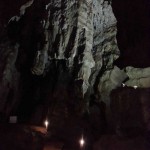In the three weeks around Christmas, nothing really happens in South Africa (there are multiple public holidays in that period, starting with Day of Reconciliation and ending with New Year’s Day). Particularly Johannesburg becomes a ghost town over these weeks, as everyone is heading out to the coast. Our two respective offices also remain closed over that period – so we had another reason to go on holiday, just three weeks after coming back from Mexico. We booked everything on relatively short notice, and our decision was to go to Tanzania first for a little under two weeks, and then to Cape Town for New Year’s Eve, since a bunch of friends from INSEAD were going to be there at that time.
For the first week of our stay in Tanzania, we decided to climb Kilimanjaro – Africa’s highest mountain at 5895m above sea level. It is one of the highest mountains that can be climbed without technical climbing expertise. We booked a six-day trip up the Machame route, since it promised to be good for acclimatization in the altitude and a scenic route as well. Also, we hoped that living and regularly exercising at Joburg’s altitude of 1750m would help against altitude sickness. In the end, we did suffer from altitude sickness quite heavily on summit day – but we made it to the top regardless (just not in very good shape). But here is the story in more detail:
Day 0 (17 December): Arrival
We flew from Johannesburg to Dar es Salaam and then onwards to Kilimanjaro International Airport. Our second flight was quite delayed, so we only got to the hotel around 11pm – to a power outage that lasted all night, so we had to be shown to our room with torches. We had decided for taking the flight and against an overland bus since we thought it would be better to not have a strenuous bus trip just before attempting to climb the mountain (which was probably a good idea).
Day 1 (18 December): Machame Gate to Machame Camp
The next morning after breakfast, we got our briefing from the two guides, and then set out to the town of Moshi to organize a few additional pieces of equipment. We had bought and brought a lot of clothes specifically for the trip, but we were both missing waterproof pants and a down jacket (both of which were definitely required). Around 10 or so, we then headed to Machame Gate which is situated at an altitude of 1800m and one of the entrances to the national park. There, we gave our luggage other than our day packs (filled with water, food and additional clothing just for the day) to the porters who would carry it up to the next camp. Then, we started hiking.
The hike of the first day was relatively short, maybe four or five hours, and led through the rainforest up to Machame Camp at 3000m. In the beginning, it was quite hot still and we were walking in shorts and sleeveless tops. However, maybe an hour into the hike, it started pouring. We immediately put on rain jackets and waterproof pants (and put rain covers on our day packs), but the rain was so strong that after a couple of hours, we were completely drenched. Even my hiking boots, which held up quite well in the beginning, got wet eventually. Our lunch break we had under two umbrellas held by our guides. Due to the rain, and the wet clothes, I also got quite cold by the time we got to camp. At least, by that time the rain had stopped and we could put our clothes to dry. The lesson learnt that day: Everything, really everything that shouldn’t get wet needs to be put in plastic bags – even in the middle of my big bag pack that had been carried by the porters, things had been getting wet.
In the evening, we also got introduced to the team that was bringing the two of us up the mountain – quite the large group just for two people: Two guides, a chef, a waiter, a camp manager, and six porters – eleven people in total! I don’t think I have ever employed the service of that many people at once over such a prolonged period of time.
Day 2 (19 December): Machame Camp to Shira Camp
On the second day, we left the rainforest and entered the heather and moorland. We started hiking earlier that day, around 8am. Whereas the trail had been a quite well-prepared path the previous day, even with wooden stairs most of the time, starting the second day it became more of a path that included lots of rocks to be climbed on or over. Especially the first part of this day’s hike went up the mountain quite steeply. Thankfully, it was not raining anymore, but it was still pretty muddy. Shira camp is located up at 3800m, and by now we could really feel that the air was getting thinner – we had to stop quite a few times just to catch our breath. This day was relatively short, so we arrived at Shira Camp already around 2pm, had a rest and then went on a short acclimatization walk up to an altitude of 3900m – the idea being to always “climb high, sleep low” to help acclimatization at the altitude. Up to this altitude, we did not feel any symptoms of altitude sickness yet other than being out of breath.
Day 3 (20 December): Shira Camp to Lava Tower to Barranco Camp
The third day, we started hiking around 7:45am. The plan for the day was to climb up to the Lava Tower at 4600m, have lunch there, and then climb down to Barranco Camp at 3900m (climb high, sleep low). On the way up to the Lava Tower, we left the heather and moorland and entered the Alpine Desert, were there are hardly any plants anymore. By the time we got to the Lava Tower, the first patches of snow were starting to appear around us. It was definitely quite a surreal experience to climb from tropical climate and rainforest to this barren and cold desert within the course of two days. The last hour or so before reaching the Lava Tower was quite tough – we had hardly any energy left, and the thin air made it really exhausting to move forward. We still weren’t feeling altitude sickness, just physical exhaustion.
Luckily, after lunch the way to the camp was basically downhill all the way – which is much less exhausting, but by the time we got to camp my legs were a bit sore from walking downhill all the time. Also, I had quite a headache due to the altitude by then – I probably hadn’t been drinking enough on the way down, since with a lot of water and tea the headache subsided quite quickly.
After we had arrived at the camp, it started raining again – but by that time we were safely in our tent, and all our stuff that had gotten wet the first day was nice and dry again now – which I was very thankful for, since I feared having to climb up to the snow-covered, windy summit with wet clothes.
Day 4 (21 December): Barranco Camp to Barafu Camp (base camp)
This was the last day before summit day, and took us up to the base camp at 4600m. We started hiking around 7am, and the first hour and a half or so was actually more scrambling up relatively steep rocks – the steepest climb of the entire trek. After that, we had to cross a valley and then continue to hike uphill for the rest of the day. In the valley, we had to cross one of the many small streams that run down Kili, and unfortunately J slipped and fell in with one leg, but thankfully nothing more serious happened.
We had lunch at Karanga hut around 4000m, in the thick clouds. From there, the path went up through the alpine desert, in a barren landscape surrounded only by rocks. Due to the altitude, we were relatively slow now and took quite some time to get up to base camp. Especially the last two hours were very exhausting, since the climb up to Barafu was relatively steep, and the camp itself was huge and it took quite some time until we had found our way to our tents. At this altitude, everything is exhausting, even tying your shoes makes you get out of breath.
In the evening, I had the first signs of real altitude sickness. Coming back into the tent from the bathroom, I suddenly felt really cold and sick and had to rest in the sleeping bag for a while until I felt better. Up here, it was already quite cold and we had to sleep with multiple layers inside the sleeping bag. We went to bed relatively early to be prepared for our early summit day.
Day 5 (22 December): Summit day. Ascent to Uhuru Peak, then down to Millennium Camp
This was the big day. We got up at midnight to start climbing at 1am, and I was feeling pretty terrible – I threw up the first time while still in the tent, and couldn’t keep any food down. While J wasn’t nauseous, she also couldn’t eat, and she had hardly slept during the short night – definitely not a good start for this tough day. We started walking around 1, with headlamps on since it was obviously pitch black. From Barafu at 4600m we had to climb up almost 1300m to reach the highest point in Africa.
On the way up, I threw up a couple of times again, and since we were both very low on energy not having eaten anything, we were very, very slow. On the way, we met a couple of people who had turned around, and also considered going back, but were encouraged by our guides to carry on, which we did. In the thin air, with almost no energy, and feeling nauseous, we really dragged ourselves forward, having to stop to take a breath every couple of meters. Most people see the sunrise from the top – we were still quite far from it on the steep slopes when the sun rose. But we carried on.
The way up was also really, really cold – especially since the cold winds were sweeping over the rocks. My clothes were holding up pretty well (I was wearing six layers on top), but J was cold before she started wearing my hard shell in addition to the ski jacket she had rented. Also, her gloves weren’t warm enough unfortunately – mine were okay with the added glove liners that I had bought (a very good idea). For me, the coldest body part were the feet – despite hiking boots, ski socks and sock liners, they went numb after a while due to walking on the icy rock for so long.
We reached Stella Point (5700m) around 7:30am, and had some sugary tea – finally, something energy-providing that would stay down! From Stella Point, it takes around 45 minutes to Uhuru Peak, and the path is not very steep anymore. However, due to the thin air, we still stopped every twenty meters or so. At 8:40am (according to our official certificates we got after the climb), we finally reached Uhuru – more than seven and a half hours after we had left Barafu. While we were somewhat proud to have made it, we were way too exhausted to celebrate – we just took a couple of pictures and then started to go back down. We had definitely been the last of the bigger morning crowd up on the summit, but on our way back towards Stella Point we still met a couple of other climbers on the way up – so at least we were not the last ones to have made it that day.
The way down was much quicker than the way up – we took a different path down, which was very gravel-ly so that we basically kept sliding down all the time. It still took us about four hours to climb down to Barafu, and about half way down J started getting very dizzy. We had to take frequent breaks, and for the final hour or so, J was supported on both sides first by the guides and later by two porters.
When we arrived at Barafu Camp, we finally had the chance to get some rest and sleep for a little while. However, J was still feeling sick, and when we woke up again and had some lunch, J couldn’t eat much before she had to throw up. However, we had to continue further down – which was going to be painful that day, but promised alleviating the altitude sickness. So on we went, down to Millennium Camp at 3700m. We still had to walk very, very slowly and take frequent breaks, but we could feel the air getting denser and at least breathing wasn’t as hard anymore.
Arriving at the camp, J was feeling a little better, but still extremely exhausted and sick, so she went to bed immediately after we had had some tea and snacks. I stayed up for dinner, and had quite the hard time convincing the waiter and the guides that they didn’t have to wake up J to feed her: “She wants to sleep, and she will be better tomorrow” – “But how can she feel better if she doesn’t eat?” – “She is just tired and exhausted, and needs the sleep more than the food.” – “But what if it’s something severe?” – “Then eating now wouldn’t help her either.” – “But she won’t have any energy to walk tomorrow!” – “She’ll eat more at breakfast when she is feeling better.” and so on. Eventually, I convinced them by promising to bring some fruits and tea to the tent for her to eat.
Day 6 (23 December): Millennium Camp to Mweka Gate
This was the last day of the hike. J was feeling well again in the morning (despite not having eaten any of the things I brought to the tent, since she was just sleeping through the night), and we had our last mountain breakfast. We also had a little bit of a discussion with our guides around the tips for the crew – it is customary to tip, and with our big crew it was quite hard to tip everyone adequately without going far above the 10-15% of the tour price that is recommended – and in addition we had had quite some challenges getting US Dollars in South Africa, so we simply didn’t have enough cash to go far beyond that. However, in the end we managed somehow.
The way down to Mweka Gate led us through the heather and moorland and then into the rainforest, and on this last day we were quite fast again, having shaken off all signs of altitude sickness. We only had a quick lunch on the way, and arrived down at the gate around noon. After all the formalities had been completed, and we had returned the rented gear to the tour office, we were dropped off at the hotel and could finally after six days have a shower again… Such a good feeling, being out of the dirty and smelly mountain clothes, and back at a reasonable altitude!
We spent one more night in the hotel in Moshi before flying to Zanzibar on Christmas Eve.
In summary, we both concluded that while this was definitely an experience, and we can proudly say that we made it to the roof of Africa, we will not do something like this again – we will stay below 3000 meters or so, where you can still actually breathe, and normal tasks don’t become an exercise.
Some pictures follow.
- Taking a break
- In the clouds
- Me with the guide
- Shira Camp
- Heather and moorland
- Mount Meru
- Porters and the Peak
- Lava tower
- View out of the tent
- Higher and higher
- Summit panorama
- On the way down











